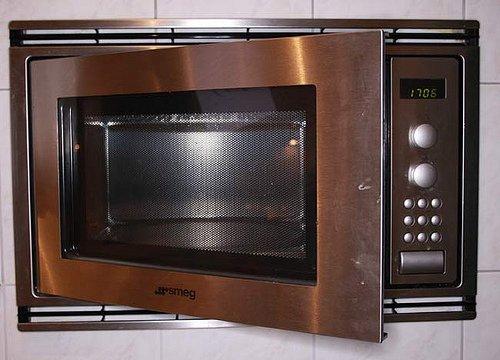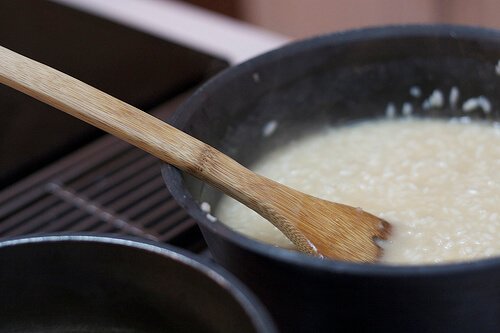
The Microwave: Why You Should Avoid It and Other Options

Written by Kate Tietje, Contributing Writer
Back when I was in high school, I remember sitting in French class one day. I don’t remember what brought it up, but the teacher told us that she didn’t have a microwave. We were honestly shocked. Why, we thought (and said). In this day and age, everyone has a microwave! It’s so convenient! How do you cook without a microwave?!
Why, indeed.
I continued to happily use my oh-so-convenient microwave for several more years. That is, until I began to move towards real food in 2009. By the end of that year, I was convicted that it needed to go. And it did — we put it away at the very end of 2009 (replaced it with my lovely Excalibur dehydrator!) and haven’t looked back. It’s been over two years, and I don’t miss it. Are you curious why I did that…and how it’s worked out?
Why Get Rid of the Microwave?
Microwaves are undeniably convenient — if you want to reheat leftovers, or defrost meat for dinner. But using them comes with a price.
The way that microwaves work is by making use of an electromagnetic field. (Hang on — it gets a little technical, but I’ll try to keep it brief and understandable. My eyes were glazing over a little as I was researching all this, and I don’t want that to happen to you!) Basically, there is a magnetron in each microwave, that creates an alternating current, acting on the electrons in the food and causing them to become “excited,” increasing their kinetic energy — which creates heat, cooking the food.
This process is basically radiation, where molecules gain or lose an electron through ionization. It doesn’t sound like that big a deal, but it actually changes the molecular structure of the food.
This magnetron and the micro-waves it produces are so dangerous that all modern microwaves have to have at least three safety measures in place so that if the door opens, the microwave stops immediately. Being exposed to micro-waves causes all sorts of problems (see below)! Standing close to the microwave is discouraged, as is staring directly at it, because microwaves can sometimes be felt in the couple inches just outside the door.
Anyone who has ever used a microwave knows that food cooked this way doesn’t look or taste like food cooked on the stove top or in a conventional oven. It burns more easily. Some things become rubbery, sticky, or have other strange textures. It doesn’t taste the same. The food can have “hot spots” and “cold spots” due to uneven heating. These are easy ways to notice that microwaving food is not the same as “normal” cooking, clearly! And it is because of this ionization.
Another problem with microwaving is the containers in which most people microwave foods — plastic, or coated paper. These can contain BPA and other chemicals that, when heated, leach into the food. We all know how harmful BPA is now! (If you haven’t heard, BPA is an endocrine disruptor that really messes up your hormones.)
Some experts have linked microwave use to:
- Leukemia and other forms of cancer
- Cataracts (from looking too closely/radiation escaping)
- Irregular heartbeat/other heart issues
- Diabetes
- Nutrient loss/damage in food
- Anemia
- Higher cholesterol levels (which suggests damage to the body)
Source: 1, 2
Okay, that’s a little bit scary. And definitely enough to make me glad I haven’t used a microwave in over two years! But what next?
Image by Katalicia1
But The Convenience…!
Like I said, sure, microwaves are convenient. Luckily, there are ways to do all those things you do with your microwave in other, safer ways!
Toaster Oven
If you want to cook or reheat a small amount of something, use a toaster oven. It heats like a regular oven, but since it’s tiny, it doesn’t take as long to heat up (nor will it make your house hot in the summer). Try using this to reheat foods or bake small amounts.
Oven
Your regular ol’ oven shouldn’t be ignored, either! I use mine all the time. We store most leftovers in Pyrex glass containers, so we simply remove the lid, pop it in the oven, and turn it on. (Putting cold glass in a cold oven won’t shock and break the glass. Though honestly Pyrex is really sturdy, and I have put frozen glass into a hot oven and not had a problem. Don’t take my word on it…but I’m saying I’ve done it.)
Stove Top
Boiling water or reheating things like soup goes just fine on the stove top, and doesn’t take much longer. Realistically, rather than have hot soup in one minute, you have it in 10. So what? Start it a few minutes earlier and do the dishes while you wait. ?
Hot Water
Do you hate realizing you haven’t defrosted the meat and it’s 5PM? Put it in a sinkful of hot water. Now, I know — “Only cool water, hot water is a breeding ground for bacteria.” If you are only going to leave the meat for 10 or 15 minutes until it’s mostly thawed, it will not have time to grow anything (that ‘cool water’ instruction is more for bathing a frozen turkey for several hours). Though honestly I have occasionally forgotten about meat for a few hours and as long as I cooked it, we’ve never gotten sick. (I’m bad…I break lots of ‘food safety’ rules all the time….)
Honestly, I don’t even have a toaster oven. I rely on my oven, stove top, and hot water to thaw or reheat anything I need and I don’t miss my microwave at all. I enjoy the convenience of being able to pop a glass container of food directly into my oven, turn it on, and go take care of something else — say, putting my kids down for a nap. When I come back, it’s perfectly hot enough. In a microwave it would have heated, stopped, and cooled back down already, not to mention been strange in texture. “Long” stuff works better with my lifestyle than “short” stuff anyway. ?
Stephanie’s note: Our family also does not use a microwave and hasn’t for about 5 years. We don’t miss it. We heat food up in primarily the sames ways as Kate’s family, although we do own a toaster oven and find it very handy for this purpose.
What About Other Stuff?
The one use that I do admittedly miss is heating those rice-filled socks to use as heating pads. They aren’t consumable (obviously) so it’s not a dangerous use. If you have a microwave still, you can use it for that. Mine is inaccessible. I’m told you can heat these up in an oven on 350 for 5 - 10 minutes; just check it frequently so it doesn’t burn. The same goes for other convenience things — if it can be done in a microwave, it can be done in another way, too.
Do you use a microwave? Why or why not? If not, how do you handle defrosting or reheating?
Top image by cookipedia
Disclosure: This post includes affiliate links.
Link nội dung: https://cmp.edu.vn/if-you-dont-want-to-cook-invest-in-a-microwave-a62973.html
